Students’ Acceptance and Tracking of a New Container-Based Virtual Laboratory
Abstract
1. Introduction
2. Background
2.1. Virtualization of Remote Laboratories
- File-system isolation. Containers can be started-up and characterized with file-system configurations to start a practical activity in the virtual laboratory.
- Resource isolation. Specific resources for each container, such as CPU and memory, are booked.
- Network isolation. Each container is like a virtual machine inside a network structure.
- Copy on write. This optimization policy allows processes to share resources in an efficient manner, which implies that the container-based laboratory deployment is very fast and with a low cost of memory.
- Change management. Already stores images can be reused to create new containers.
- Interactive interface. This fact allows lecturers to propose sets of practical activities by using shell commands and web-interfaces, as in the case of the proposed activity.
2.2. User Acceptance Models
3. Methods
3.1. Procedure
- Management of security incidents.
- Design of an access policy for a firewall, within a practical context.
- Implementation of the access policy designed.
- Checking the requirements of the practical activity.
3.2. Proposed Hypotheses
- Perceived Usefulness (PU). Usefulness perceived by the student when using the laboratories based on containers.
- Estimated Effort (EE). Ease of use (or effort) perceived by the student when using the laboratories based on containers.
- Attitude (A). Students’ resistance of using the proposed technology, and the benefits of using it for the practical activities.
- Social Influence (SI). Students’ mind perceived from colleagues and lecturers about the practical experience with the laboratories.
- Ease of Access (EA). Perceived availability about educative resources by students.
- Intention of Use (IU). Possibility of using this type of technology for other experiences in the future.
- H1. The PU factor using the CVL technology will positively influence the A factor.
- H2. The EE factor using the CVL technology will positively influence the A factor.
- H3. The A factor using the CVL technology will positively influence the IU factor.
- H4. The SI factor using the CVL technology will positively influence the IU factor.
- H5. The EA factor using the CVL technology will positively influence the IU factor.
3.3. Case of Study
- Entry, from which the ingredients of the secret potion reach the production chain.
- Kitchen, where the recipe of the potion is prepared.
- Bottling, where the potion is bottled for its distribution.
3.4. Design and Functionality
- Finding out the characteristics of the current security service of the company (if any). Checking the existence of already existing access policies. Implementation of a security policy (given that the student will verify that no policy exists).
- Forbidding any access to the plant. Dealing with a set of issues that will arise, since the students does not have administrator access to the control panel. Allowing access among nodes of the internal network.
- Analyzing the suitability of the applied policy (for instance, configuration of the external accesses). Dealing with the fact that all external accesses are forbidden. Detection of strange traffic behaviors after solving the previous issue.
- Providing the internal network with the most suitable policy access, using Uncomplicated Firewall (UFW) [43] rules. These actions will lead to a better control of the network access. In particular, Figure 7 shows an example of use, in which the student establishes a set of firewall rules, such as denying a set of TCP ports, allowing specific TCP and UDP ports, and checking the status of the firewall. All these actions are performed in the container which supports the firewall.
- Providing the external network with the most suitable policy access, also using firewall rules. These actions will lead to a better control of the network access.
- Monitoring the network log, blocking all strange IP connections and malicious traffic, and analyzing them. Figure 8 shows an example of checking the network configuration of a particular container. More advanced actions can be performed, since each container owns all the features described along the paper.
- Finding network elements (machines) that spread malicious orders, using TCPFlow [44]. Detecting their origin and associated connections. Point-to-point connections are established to destination machines, using ports of the network containers (an example of the available ports can be seen in Figure 4).
- Refining the access policy as a final step from the perspective of the HTTP application layer (malicious communications detection, analysis and filtering). After fulfilling all these tasks, the access policy will have been redesigned and the whole network effectively secured.
4. Results
4.1. Instruments and Data Collection
- Gender (t = 0.295; p-value = 0.768).
- Age Group (t = −0.208; p-value = 0.835).
- Familiarity with Cybersecurity (t = −0.139; p-value = 0.900).
- Students’ acceptance. Students were encouraged to answer an opinion questionnaire to check and validate their acceptance with respect to the technology used in each academic year. The survey is based on the UTAUT methodology [11,40]. UTAUT is a very suitable model to analyze the intention to use technology, remote virtual laboratories in our case, and their benefits. The learning outcomes by analyzing the data gathered from the study is analyzed and compared using the factors that influenced the intention of use of the laboratory.
- Students’ interactions. This data includes information about the evaluation, forums and contents, using the number of accesses, sessions, and time. A set of visualization techniques are required to analyze new technologies and virtual platforms in the education field [46]. These can allow faculties to improve the learning/teaching strategies and interactions to be employed in virtual courses. It may also allow researchers to make predictions about the students’ behavior during their process of learning, such as preventing dropouts in courses [47].
4.2. Students’ Acceptance
Validating Hypotheses of the Proposed SEM Models
- H6. The EA factor using the CVL technology will positively influence the PU factor.
- H7. The EA factor using the CVL technology will positively influence the A factor.
4.3. Students’ Tracking
5. Conclusions
Author Contributions
Funding
Acknowledgments
Conflicts of Interest
Appendix A. Statements about the Indicators of the Proposed Model
| Identifier | Question |
|---|---|
| PU 1 | I find that the proposed system very useful for learning. |
| PU 2 | Using the system allows me to do the laboratory activities in a more efficient way. |
| PU 3 | Using the system increases the productivity of my learning. |
| PU 4 | If I use the system, I think that my chances of passing are increased. |
| EE 1 | My interaction with the system has been clear and understandable. |
| EE 2 | I think it’s easy to learn how to use the system. |
| EE 3 | I find the system easy to use. |
| A 1 | I think using the system is a good idea. |
| A 2 | The system increases my interest in the proposed contents. |
| A 3 | Using the system is enjoyable. |
| A 4 | I liked using the system. |
| SI 1 | My classmates think that it is a good idea to use the system. |
| SI 2 | My instructors think it’s a good idea to use the system. |
| SI 3 | In general, all participants in the subject have sustained the use of the system. |
| EA 1 | I have been able to access all the resources that I needed to use the system. |
| EA 2 | I have learned everything necessary to be able to use the system. |
| EA 3 | The proposed system is not compatible with other learning tools. |
| EA 4 | I usually find support about the system in the subject’s forums. |
| IU 1 | I would like to reuse the system in other laboratory activities. |
| IU 2 | I would like to access the system to reinforce my learning in a freeway. |
| IU 3 | I would like to reuse the system in other subjects. |
References
- Duan, Y. Value Modeling and Calculation for Everything as a Service (XaaS) Based on Reuse. In Proceedings of the 13th International Conference on Software Engineering, Artificial Intelligence, Networking and Parallel/Distributed Computing (SNPD), Kyoto, Japan, 8–10 August 2012. [Google Scholar]
- ISACA Survey. State of Cybersecurity. Implications for 2016. Available online: https://www.isaca.org/cyber/Documents/state-of-cybersecurity_res_eng_0316.pdf (accessed on 11 January 2020).
- Martini, B.; Choo, K.K.R. Building the Next Generation of Cyber Security Professionals. In Proceedings of the 22nd European Conference on Information Systems (ECIS 2014), Tel Aviv, Israel, 9–11 June 2014. [Google Scholar]
- Hamari, J.; Koivisto, J.; Sarsa, H. Does Gamification Work?—A Literature Review of Empirical Studies on Gamification. In Proceedings of the 47th Hawaii International Conference on System Sciences, Waikoloa, Hawaii, 6–9 January 2014; pp. 3025–3034. [Google Scholar] [CrossRef]
- Cano, J.; Hernández, R.; Ros, S. Bringing an engineering lab into social sciences: Didactic approach and an experiential evaluation. IEEE Commun. Mag. 2014, 52, 101–107. [Google Scholar] [CrossRef]
- Cano, J.; Hernández, R.; Ros, S.; Tobarra, L. A distributed laboratory architecture for game based learning in cybersecurity and critical infrastructures. In Proceedings of the 13th International Conference on Remote Engineering and Virtual Instrumentation (REV), Madrid, Spain, 24–26 February 2016; pp. 183–185. [Google Scholar] [CrossRef]
- Salmerón-Manzano, E.; Manzano-Agugliaro, F. The Higher Education Sustainability through Virtual Laboratories: The Spanish University as Case of Study. Sustainability 2018, 10, 4040. [Google Scholar] [CrossRef]
- Servidio, R.; Cronin, M. PerLE: An “Open Source”, ELearning Moodle-Based, Platform. A Study of University Undergraduates’ Acceptance. Behav. Sci. 2018, 8, 63. [Google Scholar] [CrossRef] [PubMed]
- Irvine, C.; Thompson, M.; Khosalim, J. Labtainers: A Framework for Parameterized Cybersecurity Labs Using Containers; Dudley Knox Library: Monterey, CA, USA, 2017. [Google Scholar]
- Holden, R.; Karsh, B.T. The Technology Acceptance Model: Its Past and Its Future in Health Care. J. Biomed. Inform. 2010, 43, 159–172. [Google Scholar] [CrossRef] [PubMed]
- Venkatesh, V.; Morris, M.G.; Davis, G.B.; Davis, F.D. User Acceptance of Information Technology: Toward a Unified View. MIS Q. 2003, 27, 425–478. [Google Scholar] [CrossRef]
- Gomes, L.; Bogosyan, S. Current Trends in Remote Laboratories. IEEE Trans. Ind. Electron. 2009, 56, 4744–4756. [Google Scholar] [CrossRef]
- Gravier, C.; Fayolle, J.; Bayard, B.; Ates, M.; Lardon, J. State of the Art About Remote Laboratories Paradigms—Foundations of Ongoing Mutations. Int. J. Online Eng. 2008, 4, 19–25. [Google Scholar]
- Tawfik, M.; Sancristobal, E.; Martin, S.; Diaz, G.; Castro, M. State-of-the-art remote laboratories for industrial electronics applications. Technol. Appl. Electron. Teach. 2012, 2012, 359–364. [Google Scholar] [CrossRef]
- Tobarra, L.; Ros, S.; Hernández, R.; Pastor, R.; Robles-Gómez, A.; Caminero, A.C.; Castro, M. Low-Cost Remote Laboratories for Renewable Energy in Distance Education. In Proceedings of the 11th International Conference on Remote Engineering and Virtual Instrumentation (REV 2014), Porto, Portugal, 26–28 February 2014. [Google Scholar]
- Pastor, R.; Caminero, A.C.; Rama, D.S.; Hernández, R.; Ros, S.; Robles-Gómez, A.; Tobarra, L. Laboratories as a Service (LaaS): Using Cloud Technologies in the Field of Education. J. UCS 2013, 19, 2112–2126. [Google Scholar]
- Tobarra, L.; Ros, S.; Hernández, R.; Marcos-Barreiro, A.; Robles-Gómez, A.; Caminero, A.C.; Pastor, R.; Castro, M. Creation of Customized Remote Laboratories Using Deconstruction. IEEE-RITA 2015, 10, 69–76. [Google Scholar] [CrossRef]
- Al-Zoubi, A.; Hammad, B.; Ros, S.; Tobarra, L.; Hernández, R.; Pastor, R.; Castro, M. Remote Laboratories for Renewable Energy Courses at Jordan Universities; IEEE: Piscataway, NJ, USA, 2014; pp. 1–4. [Google Scholar]
- Tobarra, L.; Ros, S.; Hernández, R.; Pastor, R.; Castro, M.; Al-Zoubi, A.Y.; Hammad, B.; Dmour, M.; Robles-Gómez, A.; Caminero, A.C. Analysis of Integration of Remote Laboratories for Renewable Energy Courses at Jordan Universities; IEEE Computer Society: Piscataway, NJ, USA, 2015; pp. 1–5. [Google Scholar]
- Tobarra, L.; Pastor, R.; Robles-Gómez, A.; Cano, J.; Hammad, B.; Al-Zoubi, A.; Hernández, R.; Castro, M. Impact of Online Education in Jordan: Results from the MUREE Project. In Proceedings of the 2019 IEEE Global Engineering Education Conference (EDUCON), Dubai, UAE, 9–11 April 2019; pp. 306–313. [Google Scholar] [CrossRef]
- Shankar, B.; Sarithlal, M.; Vijayan, V.; Freeman, J.; Achuthan, K. Remote Triggered Solar Thermal Energy Parabolic Trough laboratory: Effective implementation and future possibilities for Virtual Labs. In Proceedings of the 2013 IEEE International Conference on Control Applications (CCA), Hyderabad, India, 28–30 August 2013; pp. 472–476. [Google Scholar] [CrossRef]
- Rao, P.; Dinesh, P.; Ilango, G.; Nagamani, C. Laboratory course on solar photovoltaic systems based on low cost equipment. In Proceedings of the 2013 IEEE International Conference in MOOC Innovation and Technology in Education (MITE), Jaipur, India, 20–22 December 2013; pp. 146–151. [Google Scholar] [CrossRef]
- Ros, S.; Robles-Gómez, A.; Hernández, R.; Caminero, A.C.; Pastor, R. Using Virtualization and Automatic Evaluation: Adapting Network Services Management Courses to the EHEA. IEEE Trans. Educ. 2012, 55, 196–202. [Google Scholar] [CrossRef]
- Bora, U.J.; Ahmed, M. E-learning using Cloud Computing. Intl. J. Sci. Mod. Eng. 2013, 1, 9–13. [Google Scholar]
- IBM Corporation. Cloud Computing Saves Time, Money and Shortens Production Cycle. Available online: http://www-935.ibm.com/services/in/cio/pdf/dic03001usen.pdf (accessed on 11 January 2020).
- Selviandro, N.; Hasibuan, Z. Cloud-Based E-Learning: A Proposed Model and Benefits by Using E-Learning Based on Cloud Computing for Educational Institution. In Information and Communication Technology; Lecture Notes in Computer Science; Springer: Berlin, Germany, 2013; Volume 7804. [Google Scholar]
- Caminero, A.C.; Ros, S.; Hernández, R.; Robles-Gómez, A.; Tobarra, L.; Granjo, P.J.T. VirTUal remoTe labORatories Management System (TUTORES): Using Cloud Computing to Acquire University Practical Skills. IEEE Trans. Learn. Technol. 2016, 9, 133–145. [Google Scholar] [CrossRef]
- Sianipar, J.H.; Willems, C.; Meinel, C. A Container-Based Virtual Laboratory for Internet Security e-Learning. Int. J. Learn. Teach. 2016, 2. [Google Scholar] [CrossRef]
- Tobarra, L.; Robles-Gómez, A.; Pastor, R.; Hernández, R.; Cano, J.; López, D. Web of Things Platforms for Distance Learning Scenarios in Computer Science Disciplines: A Practical Approach. Technologies 2019, 7, 17. [Google Scholar] [CrossRef]
- Tobarra, L.; Robles-Gómez, A.; Pastor, R.; Hernández, R.; Duque, A.; Cano, J. A Cybersecurity Experience with Cloud Virtual-Remote Laboratories. Proceedings 2019, 31, 1003. [Google Scholar] [CrossRef]
- EVE-ND, Emulated Virtual Environment—Next Generation. Available online: http://www.eve-ng.net/index.php/downloads/eve-ng (accessed on 11 January 2020).
- Fernández-Caramés, T.M.; Fraga-Lamas, P. Towards Next Generation Teaching, Learning, and Context-Aware Applications for Higher Education: A Review on Blockchain, IoT, Fog and Edge Computing Enabled Smart Campuses and Universities. Appl. Sci. 2019, 9, 4479. [Google Scholar] [CrossRef]
- Robles-Gómez, A.; Tobarra, L.; Pastor, R.; Hernández, R.; Duque, A.; Cano, J. Analyzing the Students’ Learning Within a Container-based Virtual Laboratory for Cybersecurity. In Proceedings of the Seventh International Conference on Technological Ecosystems for Enhancing Multiculturality, León, Spain, 16–18 October 2019; pp. 275–283. [Google Scholar] [CrossRef]
- Scheffel, M.; Drachsler, H.; Stoyanov, S.; Specht, M. Quality Indicators for Learning Analytics. Educ. Technol. Soc. 2014, 17, 117–132. [Google Scholar]
- Cruz-Benito, J.; Sánchez-Prieto, J.C.; Therón, R.; García-Peñalvo, F.J. Measuring Students’ Acceptance to AI-Driven Assessment in eLearning: Proposing a First TAM-Based Research Model. In Learning and Collaboration Technologies. Designing Learning Experiences; Zaphiris, P., Ioannou, A., Eds.; Springer International Publishing: Cham, Switzerland, 2019; pp. 15–25. [Google Scholar]
- Scherer, R.; Siddiq, F.; Tondeur, J. The technology acceptance model (TAM): A meta-analytic structural equation modeling approach to explaining teachers’ adoption of digital technology in education. Comput. Educ. 2019, 128, 13–35. [Google Scholar] [CrossRef]
- Davis, F.D. Perceived Usefulness, Perceived Ease of Use, and User Acceptance of Information Technology. MIS Q. 1989, 13, 319–340. [Google Scholar] [CrossRef]
- Halili, S.H.; Sulaiman, H. Factors influencing the rural students’ acceptance of using ICT for educational purposes. Kasetsart J. Soc. Sci. 2018. [Google Scholar] [CrossRef]
- Chao, C.M. Factors Determining the Behavioral Intention to Use Mobile Learning: An Application and Extension of the UTAUT Model. Front. Psychol. 2019, 10, 1652. [Google Scholar] [CrossRef] [PubMed]
- Kim, S.; Lee, K.H.; Hwang, H.; Yoo, S. Analysis of the factors influencing healthcare professionals’ adoption of mobile electronic medical record (EMR) using the unified theory of acceptance and use of technology (UTAUT) in a tertiary hospital. BMC Med. Inform. Decis. Mak. 2016, 16, 12. [Google Scholar] [CrossRef]
- Bielby, W.T.; Hauser, R.M. Structural Equation Models. Annu. Rev. Sociol. 1977, 3, 137–161. [Google Scholar] [CrossRef]
- Liu, I.F.; Chen, M.C.; Sun, Y.S.; Wible, D.; Kuo, C.H. Extending the TAM model to explore the factors that affect Intention to Use an Online Learning Community. Comput. Educ. 2010, 54, 600–610. [Google Scholar] [CrossRef]
- UFW—Uncomplicated Firewall. Available online: https://help.ubuntu.com/community/UFW (accessed on 11 January 2020).
- TCPFlow. Available online: https://github.com/simsong/tcpflow (accessed on 11 January 2020).
- Shapiro, S.S.; Wilk, M.B. An Analysis of Variance Test for Normality (Complete Samples). Biometrika 1965, 52, 591–611. [Google Scholar] [CrossRef]
- Saura, J.R.; Reyes-Menendez, A.; Bennett, D.R. How to Extract Meaningful Insights from UGC: A Knowledge-Based Method Applied to Education. Appl. Sci. 2019, 9, 4603. [Google Scholar] [CrossRef]
- Lee, S.; Chung, J.Y. The Machine Learning-Based Dropout Early Warning System for Improving the Performance of Dropout Prediction. Appl. Sci. 2019, 9, 3093. [Google Scholar] [CrossRef]
- Ros, S.; Hernández, R.; Caminero, A.; Robles, A.; Barbero, I.; Maciá, A.; Holgado, F.P. On the use of extended TAM to assess students’ acceptance and intent to use third-generation learning management systems. Br. J. Educ. Technol. 2015, 46, 1250–1271. [Google Scholar] [CrossRef]
- León, J.A.M.; Cantisano, G.T.; Mangin, J.P.L. Leadership in Nonprofit Organizations of Nicaragua and El Salvador: A Study from the Social Identity Theory. Span. J. Psychol. 2009, 12, 667–676. [Google Scholar] [CrossRef]
- Hooshyar, D.; Pedaste, M.; Yang, Y. Mining Educational Data to Predict Students’ Performance through Procrastination Behavior. Entropy 2019, 22, 12. [Google Scholar] [CrossRef]
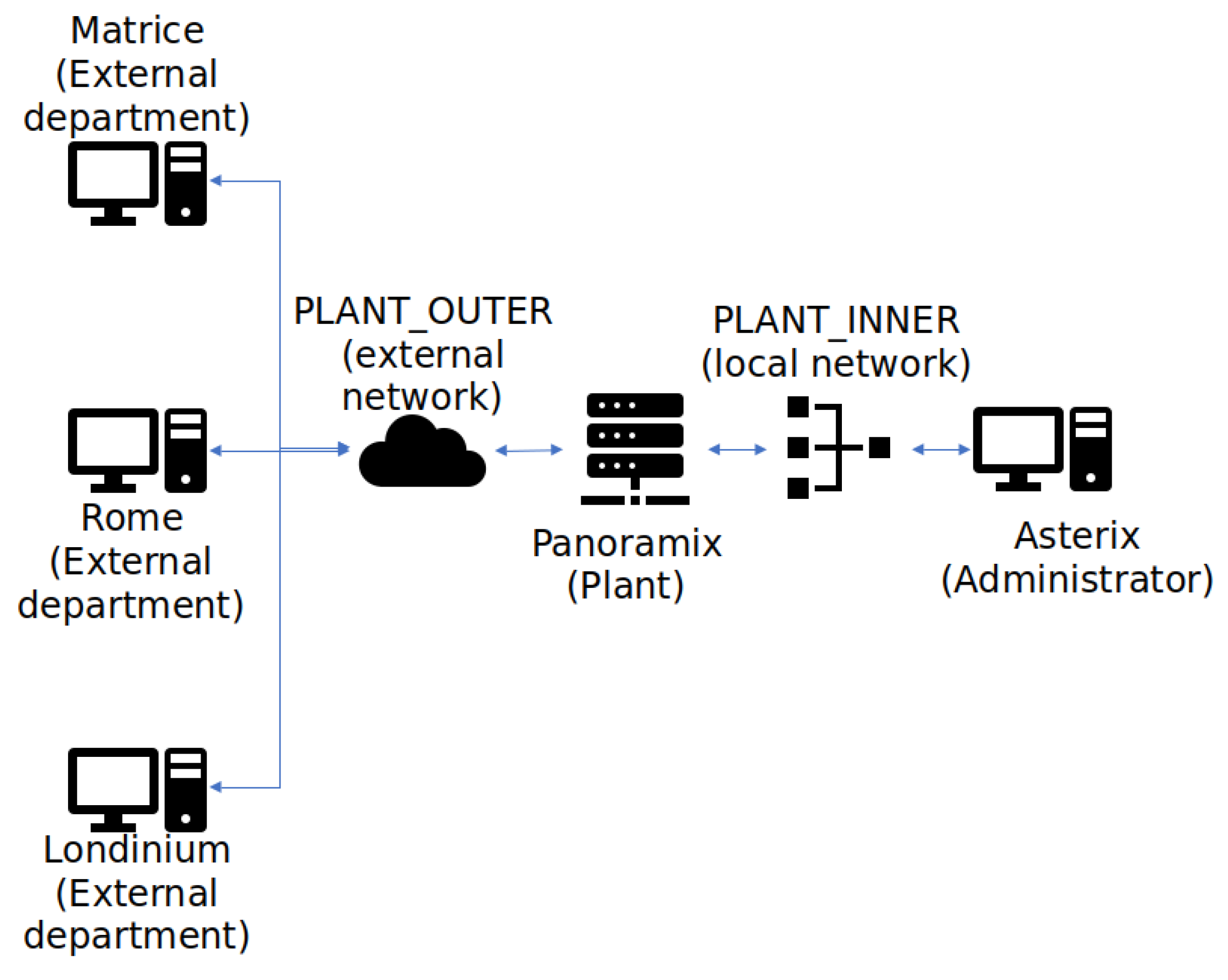

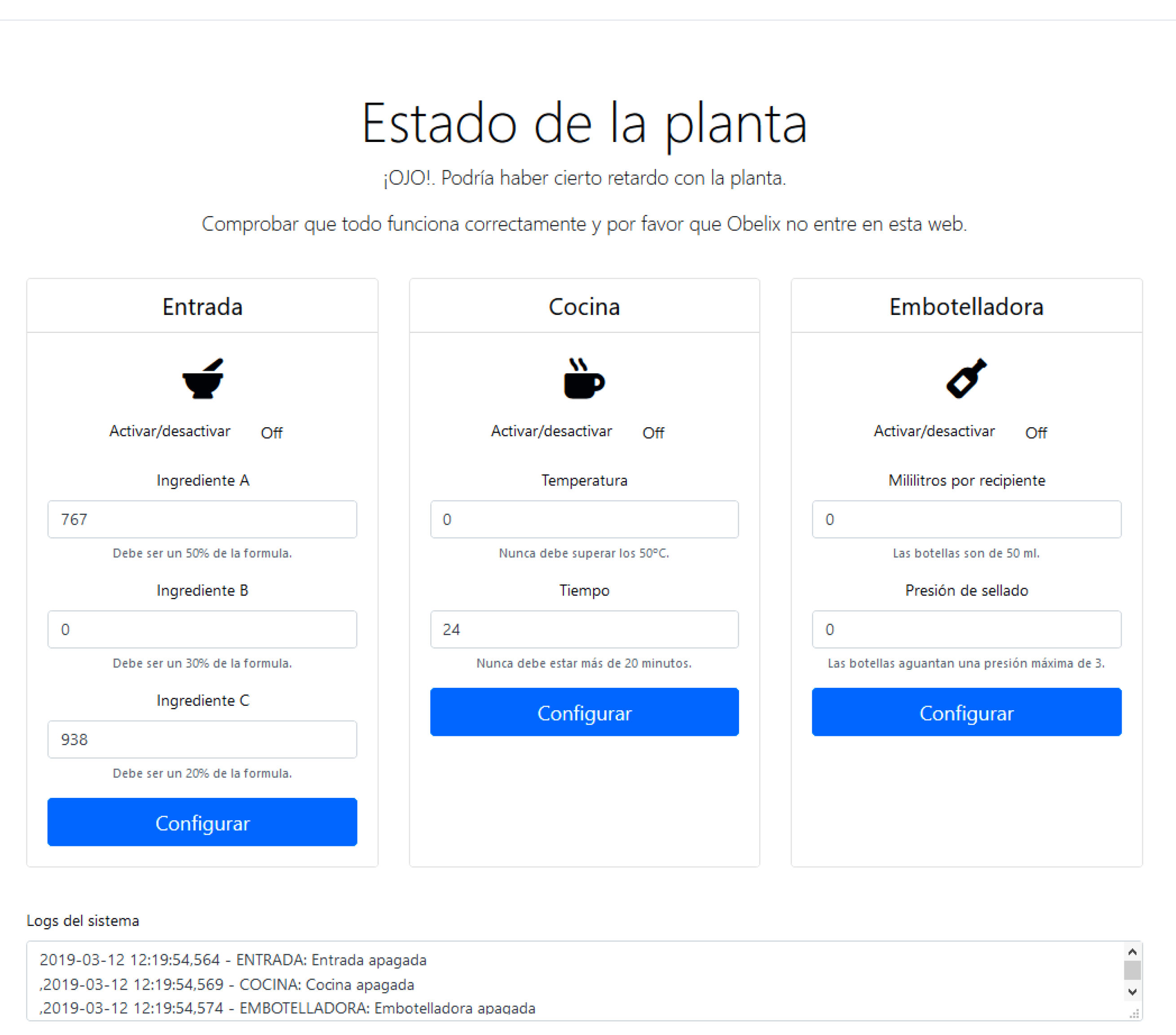


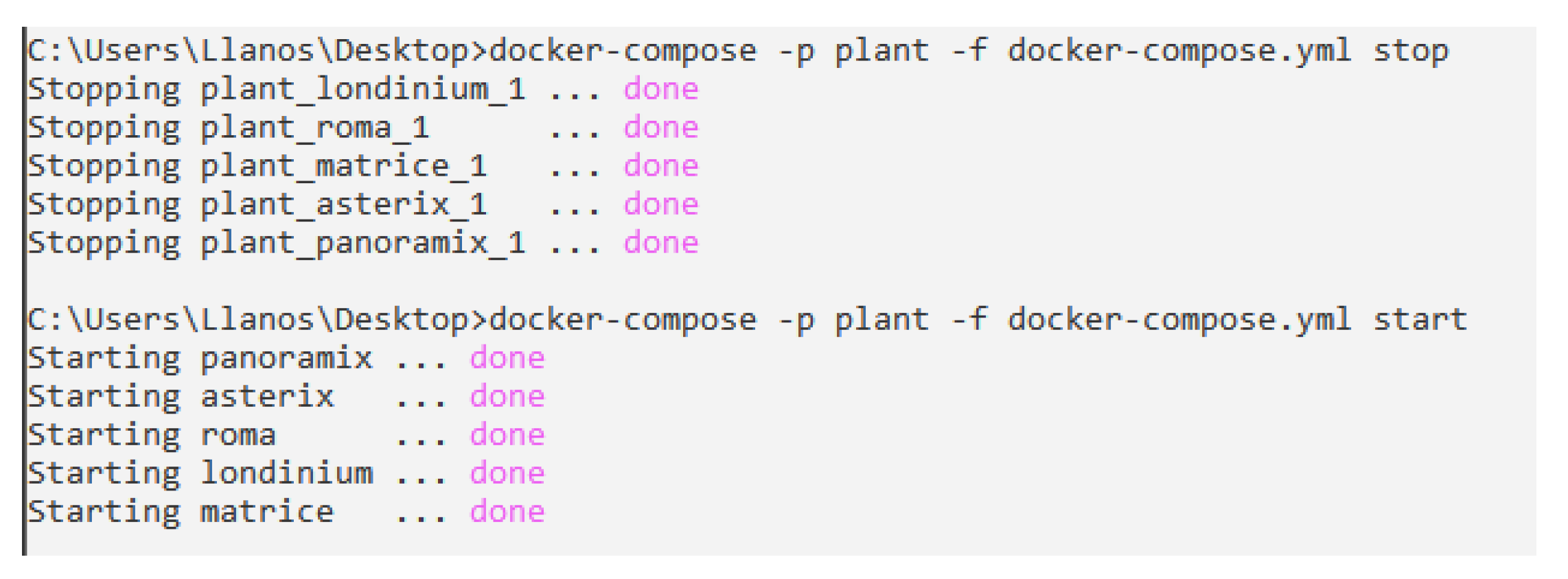

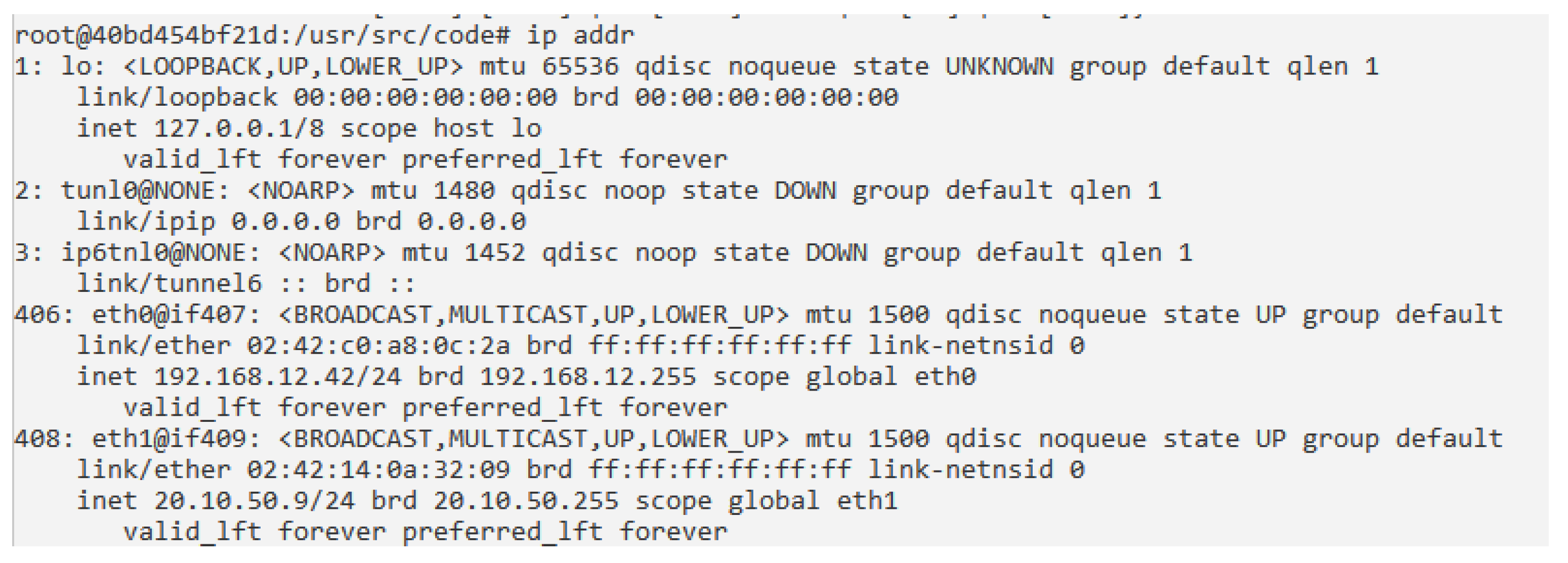


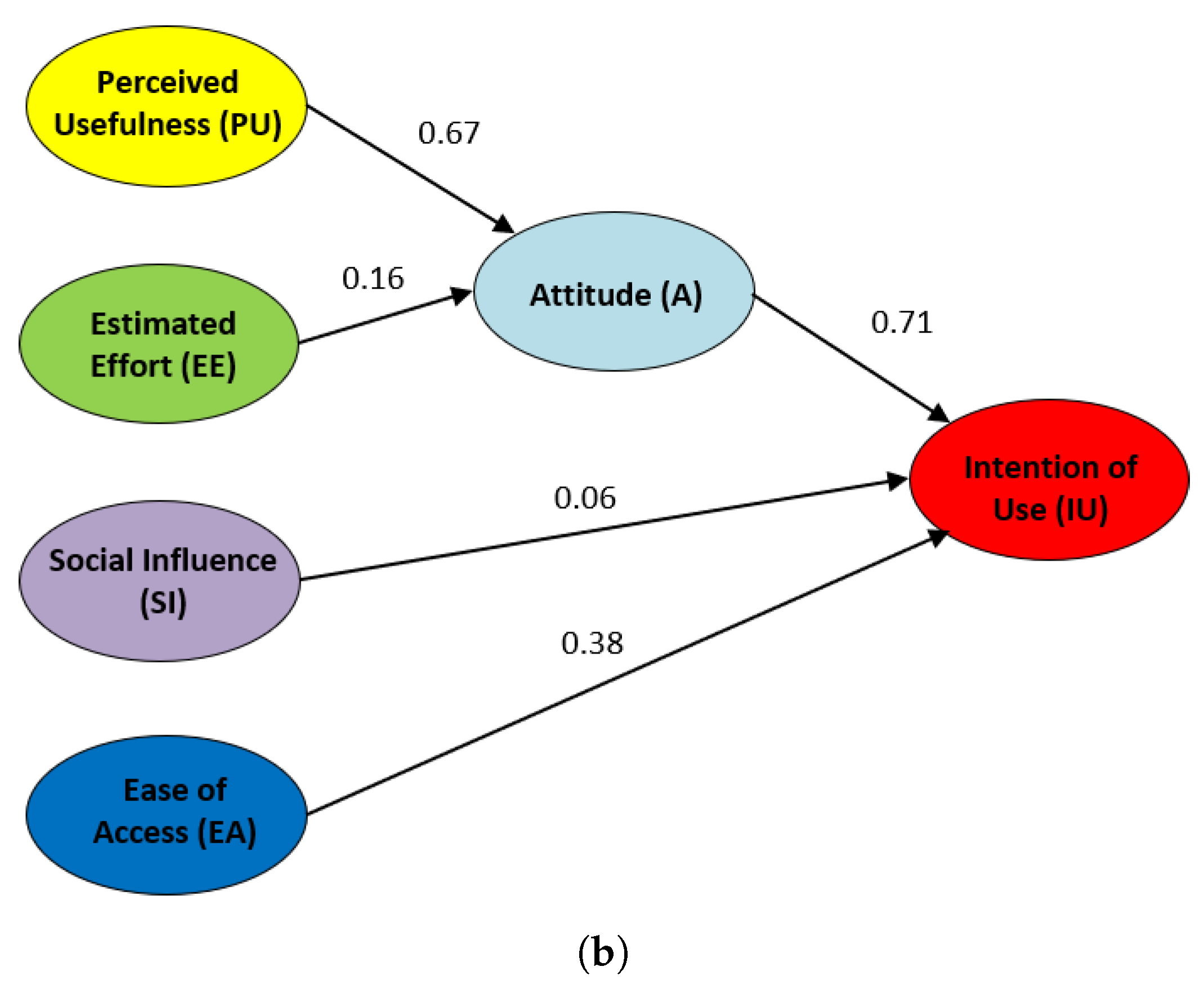







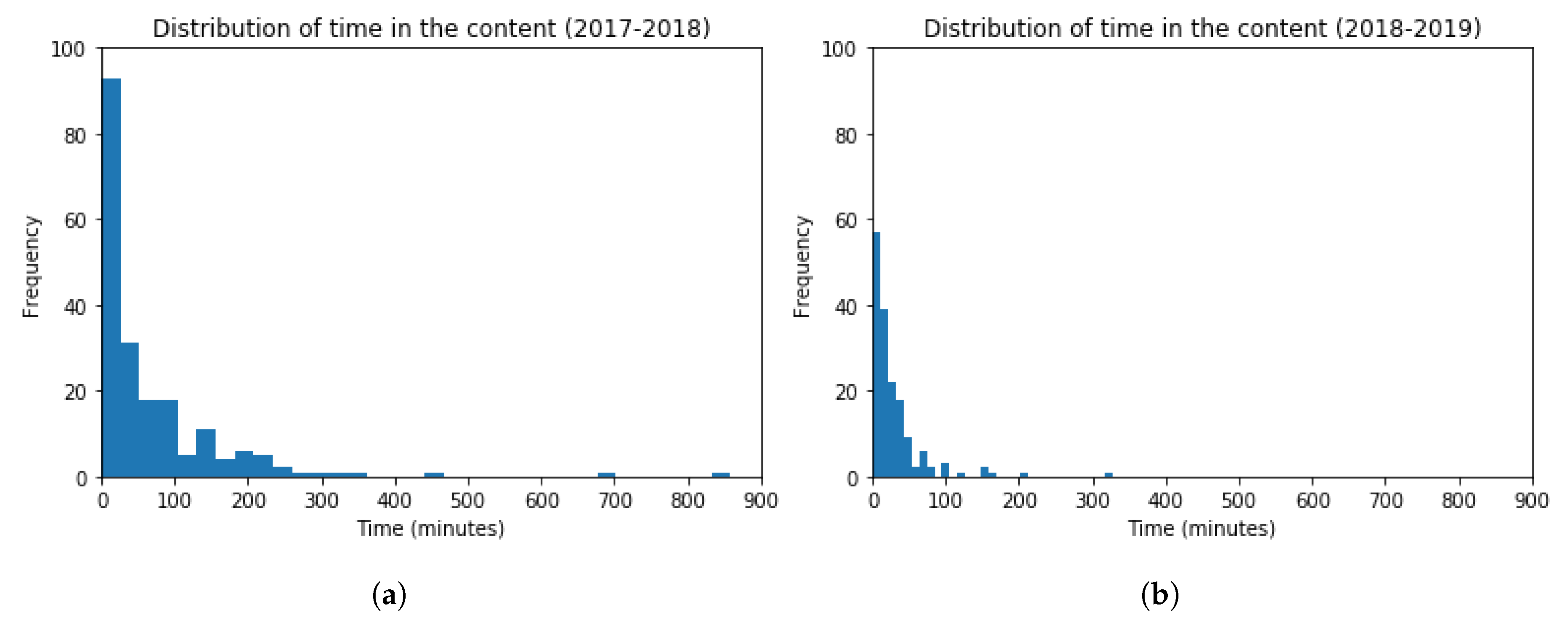
| Demographic | 2017–2018 (%) | 2018–2019 (%) | |
|---|---|---|---|
| Gender | Male | 89.15% | 89.47% |
| Female | 10.85% | 10.53% | |
| Age Group | ≤30 years | 30.23% | 18.43% |
| 30–40 years | 42.64% | 36.84% | |
| 40–50 years | 24.03% | 36.84% | |
| ≥50 years | 3.10% | 7.89% | |
| Familiarity | Very unfamiliar | 28.68% | 18.42% |
| with | Unfamiliar | 18.60% | 15.79% |
| Cybersecurity | Neutral | 24.03% | 28.95% |
| Familiar | 12.41% | 23.68% | |
| Very Familiar | 16.28% | 13.16% |
| Academic Year | PU | EE | A | SI | EA | IU |
|---|---|---|---|---|---|---|
| 2017–2018 | 3.93 | 4.13 | 4.11 | 3.67 | 3.40 | 4.04 |
| 2018–2019 | 4.45 | 3.89 | 4.51 | 3.89 | 4.03 | 4.37 |
| Indicator | Strongly Agree | Agree | Neutral | Disagree | Strongly Disagree |
|---|---|---|---|---|---|
| PU | 33.33% | 44.96% | 15.50% | 5.43% | 0.78% |
| EE | 47.29% | 28.68% | 16.28% | 6.98% | 0.78% |
| A | 47.29% | 31.01% | 16.28% | 4.65% | 0.78% |
| SI | 17.05% | 35.66% | 42.64% | 4.65% | 0.00% |
| EA | 5.43% | 48.84% | 38.76% | 6.98% | 0.00% |
| IU | 47.29% | 26.36% | 14.73% | 10.08% | 1.55% |
| Indicator | Strongly Agree | Agree | Neutral | Disagree | Strongly Disagree |
|---|---|---|---|---|---|
| PU | 57.9% | 39.5% | 2.6% | 0.0% | 0.0% |
| EE | 26.3% | 52.6% | 13.2% | 5.3% | 2.6% |
| A | 68.4% | 23.7% | 7.9% | 0.0% | 0.0% |
| SI | 21.2% | 44.9% | 31.2% | 2.7% | 0.0% |
| EA | 31.3% | 58.0% | 8.0% | 2.7% | 0.0% |
| IU | 55.1% | 28.8% | 13.4% | 2.7% | 0.0% |
© 2020 by the authors. Licensee MDPI, Basel, Switzerland. This article is an open access article distributed under the terms and conditions of the Creative Commons Attribution (CC BY) license (http://creativecommons.org/licenses/by/4.0/).
Share and Cite
Tobarra, L.; Robles-Gómez, A.; Pastor, R.; Hernández, R.; Duque, A.; Cano, J. Students’ Acceptance and Tracking of a New Container-Based Virtual Laboratory. Appl. Sci. 2020, 10, 1091. https://doi.org/10.3390/app10031091
Tobarra L, Robles-Gómez A, Pastor R, Hernández R, Duque A, Cano J. Students’ Acceptance and Tracking of a New Container-Based Virtual Laboratory. Applied Sciences. 2020; 10(3):1091. https://doi.org/10.3390/app10031091
Chicago/Turabian StyleTobarra, Llanos, Antonio Robles-Gómez, Rafael Pastor, Roberto Hernández, Andrés Duque, and Jesús Cano. 2020. "Students’ Acceptance and Tracking of a New Container-Based Virtual Laboratory" Applied Sciences 10, no. 3: 1091. https://doi.org/10.3390/app10031091
APA StyleTobarra, L., Robles-Gómez, A., Pastor, R., Hernández, R., Duque, A., & Cano, J. (2020). Students’ Acceptance and Tracking of a New Container-Based Virtual Laboratory. Applied Sciences, 10(3), 1091. https://doi.org/10.3390/app10031091







